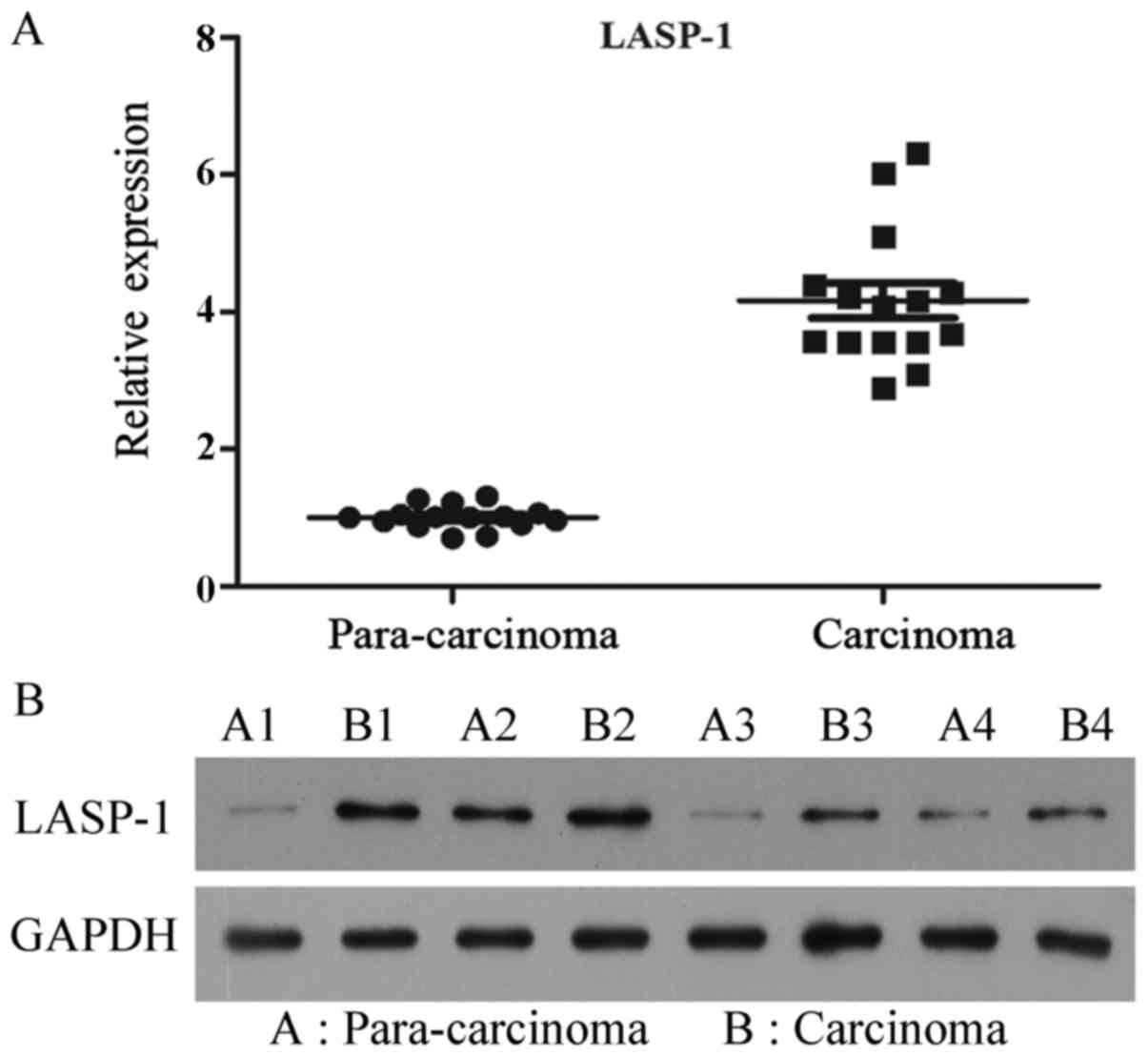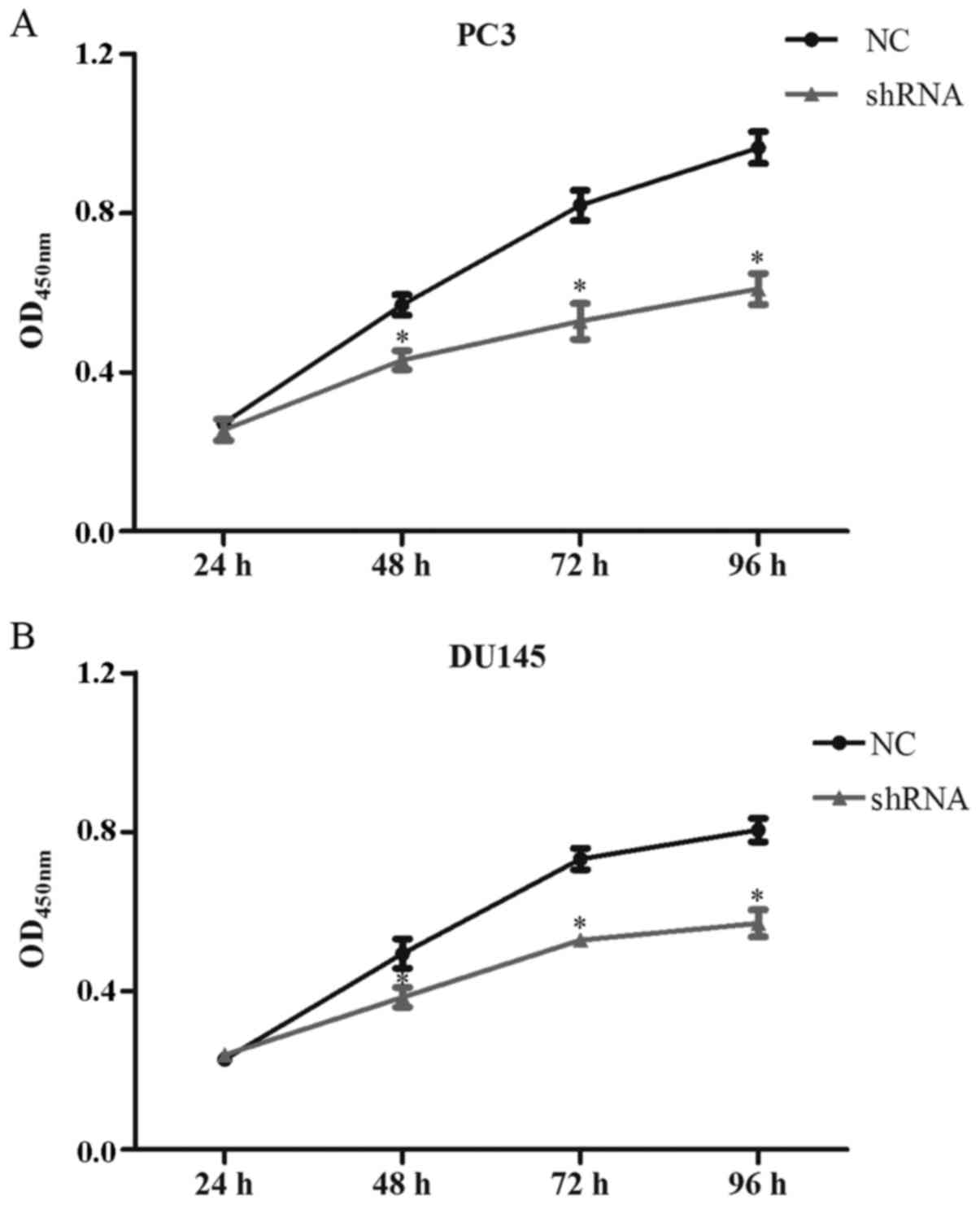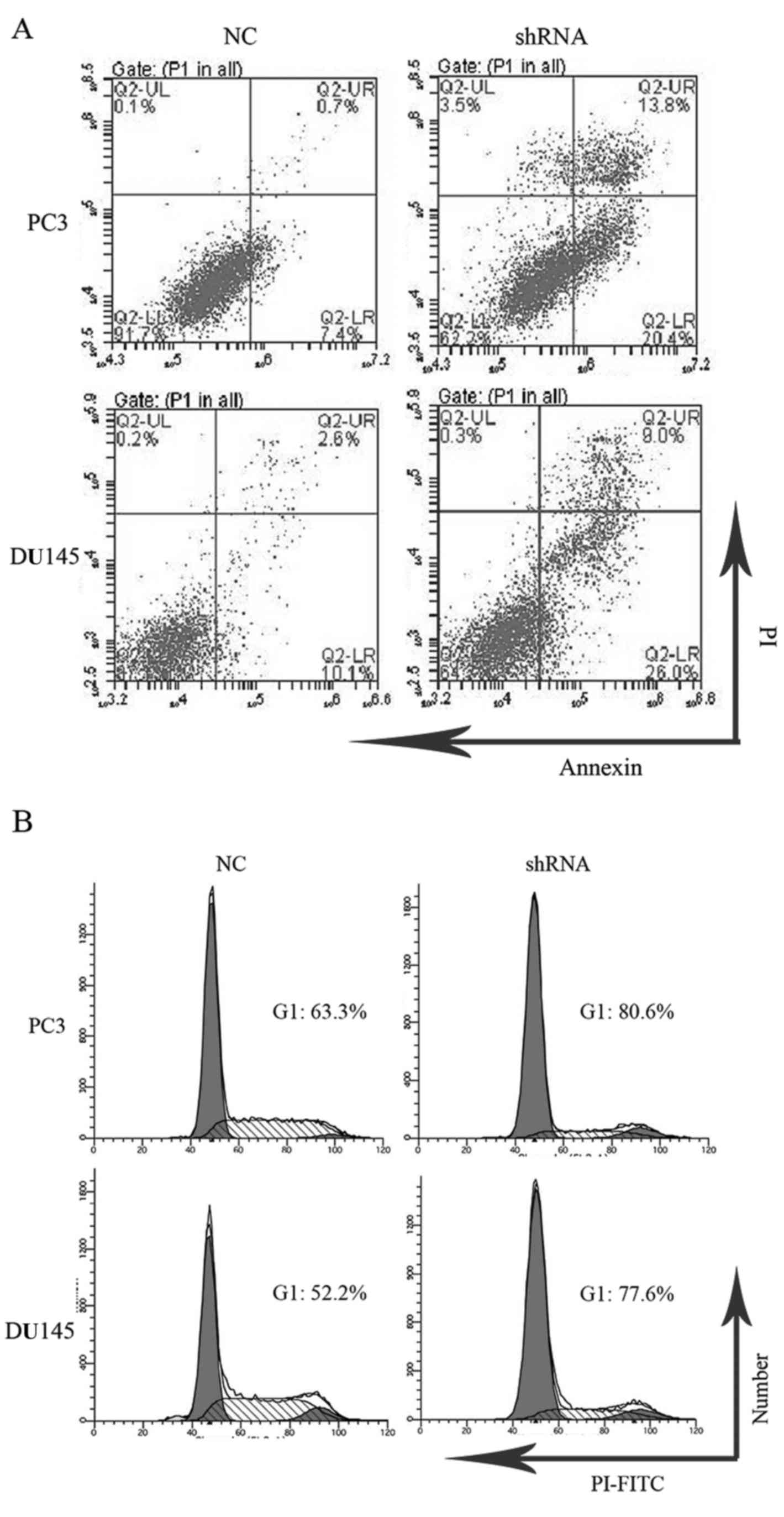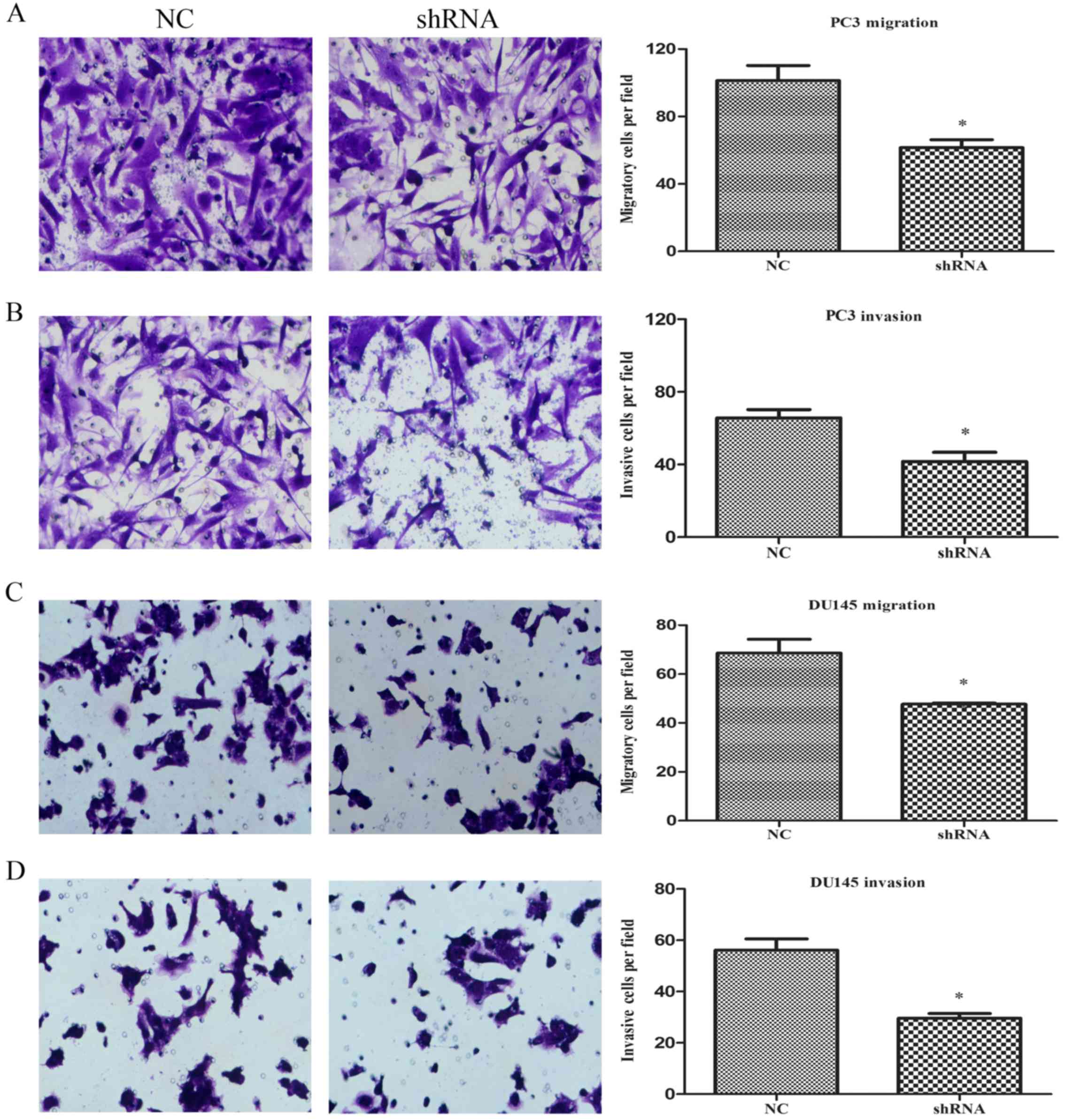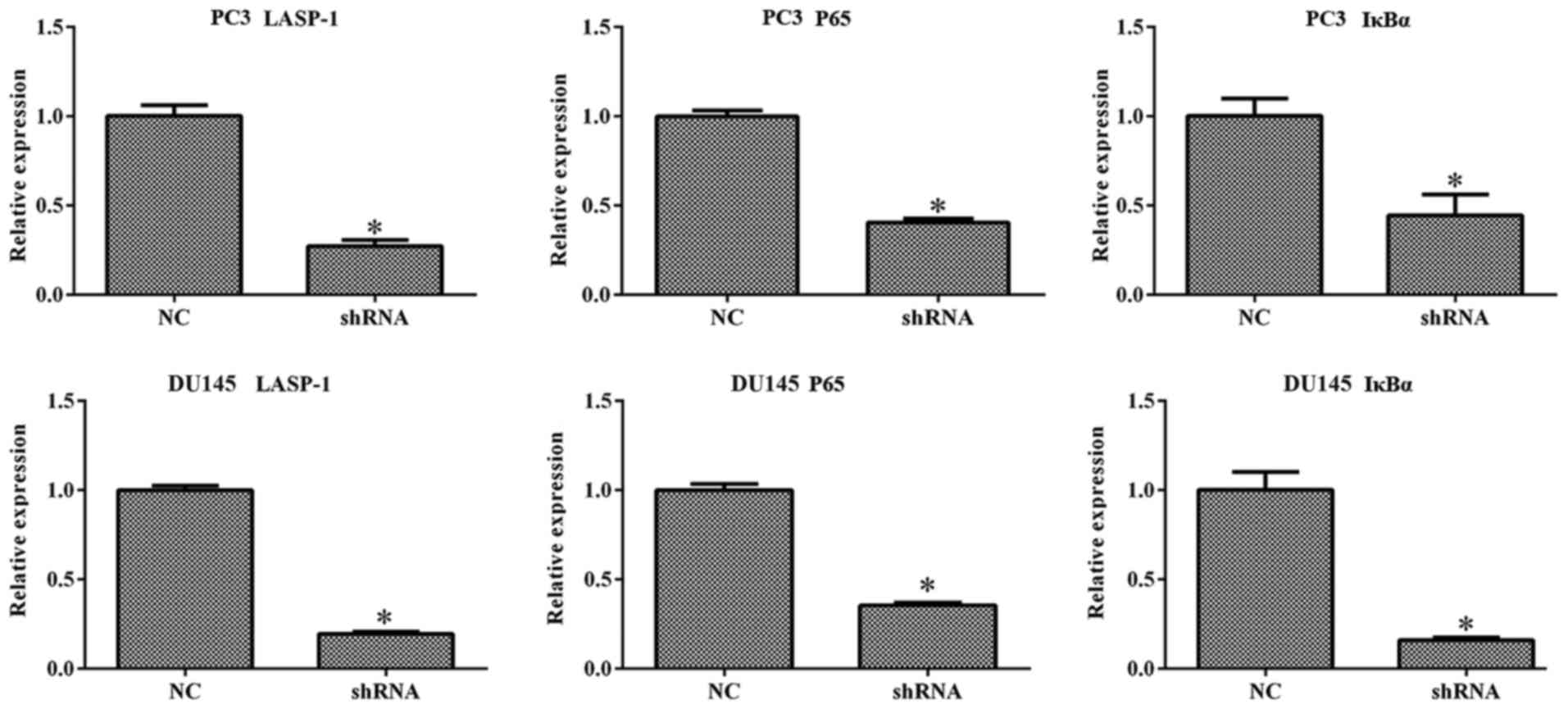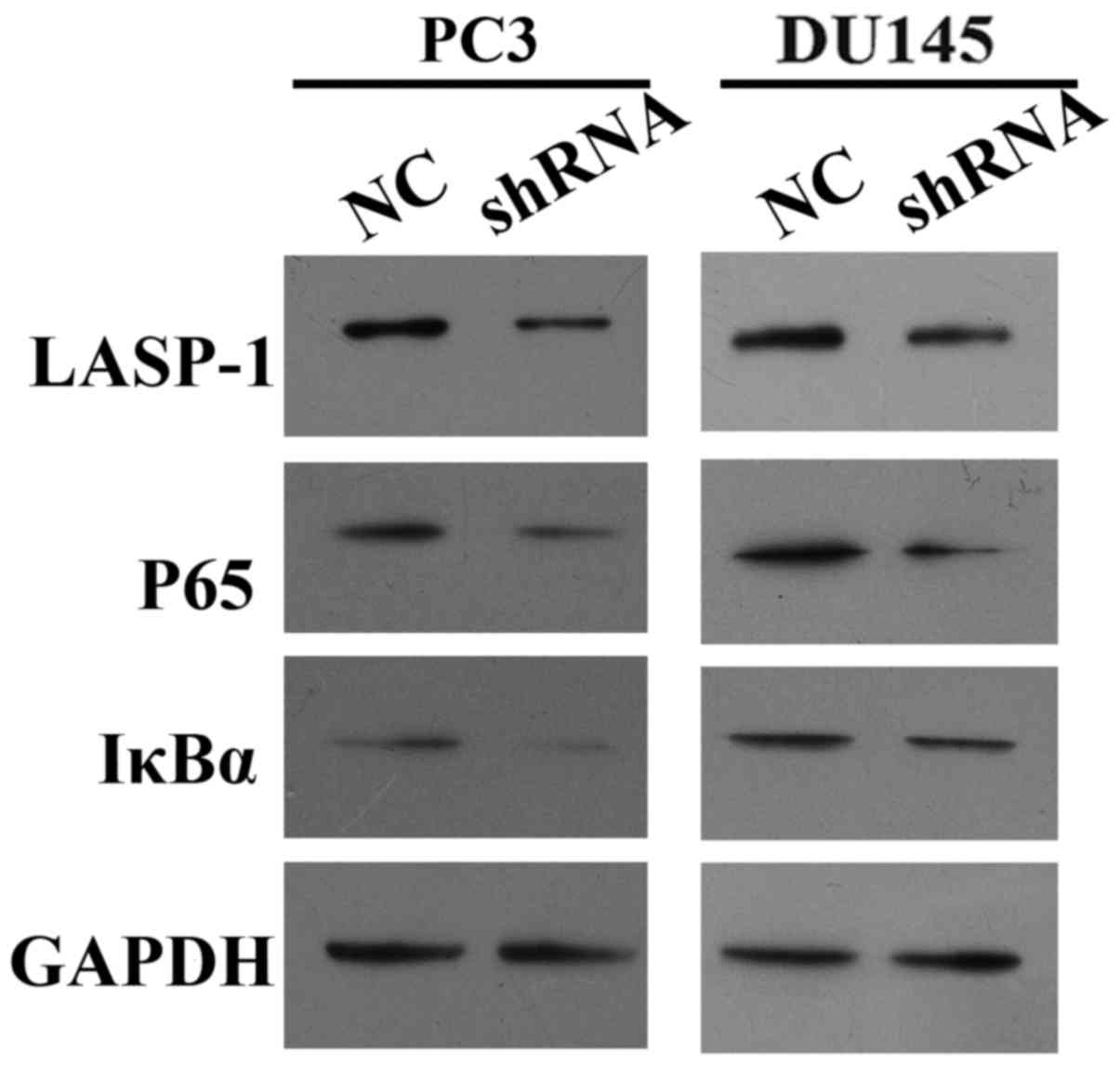Suppression of LASP-1 attenuates the carcinogenesis of prostatic cancer cell lines: Key role of the NF-κB pathway
- Authors:
- Published online on: November 7, 2016 https://doi.org/10.3892/or.2016.5223
- Pages: 341-347
Abstract
Introduction
Prostate cancer (PCa) continues to be the most frequently diagnosed cancer among males and is the cause of severe health issues in males worldwide (1). According to 2015 statistics (2), PCa ranks second as a leading cause of cancer-related deaths in men in the USA. Although most cases of PCa are curable, there is still 10–20% of PCa patients with poor prognosis who develop castration-resistant prostate cancer (3). Generally, the risk factors for PCa may be divided into an exogenous category, including aging, oxidative stress and family, and an endogenous category, including a rich fat diet and environmental agents (4,5). In addition to the multiple risk factors, the prognosis following traditional treatment modalities also varies greatly. The overall survival time of patients may range from 15 years to 2 years without a clear explanation (6,7). Thus, it is difficult to provide accurate clinical recommendations for PCa.
In recent years, studies regarding the dysregulation of microRNAs in PCa have been extensively performed. Molecular alterations associated with the miR regulation derived from these investigations have provided various potential targets involved in the oncogenesis and development of PCa (8–11). One of these newly explored targets is the LIM and SH3 protein 1 (LASP-1), which encodes a membrane-bound protein of 261 amino acids containing an N-terminal LIM domain (12,13). Although the exact biological function of LASP-1 has yet to be revealed, its association with multiple malignancies, including breast, colorectal, hepatocellular and bladder cancer, is well established (14–18). However, even with extensive interest in the function of LASP-1 in carcinogenesis, little effort has been made to elucidate the role of LASP-1 in PCa, not to mention assessment of its potential as an anti-PCa therapy.
A well establishment pathway involved in the growth of multiple types of tumor cells is nuclear transcription factor NF-κB (19,20). This factor regulates the expression of immediate-early and stress response genes which are mainly implicated in acute inflammatory responses in various diseases. In addition, regulation of the level of NF-κB has achieved considerable outcome in the treatment of various cancer types (21,22). Regarding PCa, the critical role of NF-κB in the proliferation of PCa cells was also verified (23,24), but to the best of our knowledge, no studies have given attention to the association between LASP-1 and NF-κB in PCa. Thus, a comprehensive study attempting to reveal the interaction between the two indicators may promote the development of anti-PCa therapies and the understanding of the mechanism of the carcinogenesis of PCa.
In the present study, for the first time, the expression level of LASP-1 in human PCa clinical samples was investigated. Then, the expression of LASP-1 in human PCa cell lines PC3 and DU145 was regulated by transfection of specific short hairpin RNA (shRNA) and the influence of LASP-1 knockdown on cell growth, cell cycle distribution, apoptosis, migration and invasion was detected. To preliminarily reveal the mechanism through which LASP-1 exerts its function in PCa cells, the expression levels of NF-κB-related molecules were quantified by RT-qPCR and western blot assay. It was expected that the function of LASP-1 in PCa and the pathway through which LASP-1 contributes to the formation and progression of PCa could be partially elucidated by the findings in the present study.
Materials and methods
Chemicals and cell cultures
Antibodies against LASP-1, NF-κB subunit p65 (P65), IκBα and GAPDH were purchased from Promega (Madison, WI, USA). Human PCa cell lines DU145 and PC3 were obtained from the American Type Culture Collection (ATCC; Manassas, VA, USA). DU145 cells were cultured in Eagles minimum essential medium (EMEM)supplemented with 1.8 mM CaCl2 and PC3 cells were cultured in F-12 medium. Both media were supplemented with 10% fetal bovine serum (FBS) and 1% penicillin/streptomycin. For experimental use, cells from three to six passages were employed.
Patients and PCa specimen collection
For detection of LASP-1 expression in clinical samples, 15 pairs of PCa and para-carcinoma tissues were collected from patients at The Second Hospital of Shandong University. All the samples met the following criteria: i) carcinoma tissues collected from nephrectomy were defined as primary prostatic adenocarcinoma while para-carcinoma samples were collected from kidney tissues of benign prostatic hyperplasia via renipuncture; ii) detailed information was available concerning the clinicopathological and prognostic characteristics of all the patients enrolled in the present study (Table I). Patients who had undergone any therapy for PCa before the surgical procedure were excluded. The present study was approved by the Ethics Committee of the Second Hospital of Shandong University. The Ethics Committee approved the related screening, inspection, and data collection of the patients, and all subjects signed a written informed consent form. All studies were undertaken following the provisions of the Declaration of Helsinki.
Knockdown of the LASP-1 gene in PCa cells by shRNA
The target sequence for LASP-1-specific shRNA (5′-GAAUCAAGAAGACCCAGGATT-3′) and the negative control (NC) shRNA (5′-UUCUCCGAACGUGUCACGUTT-3′) were obtained from GeneChem Biotech (Shanghai, China). Two PCa lines were grouped into two treatment groups, respectively: cells treated with NC-shRNA and cells treated with LASP-1-shRNA. Transfections were conducted using transfection agents obtained from Applygen Technologies Inc. (Beijing, China) (no. c1507) according to the manufacturer's instructions. Stable transfected cells for further experiments were screened in medium in the presence of G418 (0.5 µg/µl).
Real-time quantitative PCR (RT-qPCR)
Whole RNA in the different samples was extracted using RNAsimple Total RNA kit according to the manufacturers instructions (no. DP419; Tiangen, Beijing, China). GAPDH was selected as the reference gene. Then, the RNA was reversely transcribing to cDNA templates using Super M-MLV Reverse Transcriptase (no. RP6502; BioTeke, Beijing, China). The final RT-qPCR reaction mixture of volume 20 µl consisted of 10 µl of SYBR-Green Master Mix, 0.5 µl of each primer (LASP-1 forward, 5′-TTCCATTGCGAGACCTGC-3′ and reverse, 5′-TGCCACTACGCTGAAACCT-3′; P65 forward, 5′-CTTACACTTAGCAATCATCCACCTT-3′ and reverse, 5′-GCAAATCCTCCACCACATCTT-3′; IκBα forward, 5′-CTGATGGAGTACCCTGAGGCTAT-3′ and reverse, 5′-TGTCCGCAATGGAGGAGAAGT-3′; GAPDH forward, 5′-TATGATGATATCAAGAGGGTAGT-3′ and reverse, 5′-TGTATCCAAACTCATTGTCATAC-3′), 1 µl of the cDNA template, and 8 µl of RNase-free H2O. Thermal cycling parameters for the amplification were set-up as follows: a denaturation step at 94°C for 2 min, followed by 40 cycles at 94°C for 20 sec, 58°C for 20 sec and 72°C for 20 sec. Relative expression level of the targeted gene was calculated with Exicycler™ 96 (Bioneer, Daejeon, Korea) according to the method 2−ΔΔCt.
Western blot analysis
Protein product of different samples was extracted using Whole Protein Extraction kit according to the manufacturers instructions (WLA019; Wanleibio, Shenyang, China) and GAPDH was used as a reference protein. The concentration of the extracted protein samples was determined according to the BCA method. For western blot assay, 40 µg of protein in 20 µl solution was subject to a 13% sodium dodecylsulfate polyacrylamide gel electrophoresis (SDS-PAGE), and the proteins were subsequently transferred onto polyvinylidene difluoride (PVDF) membranes. Then, the membranes were washed in TTBS for 5 min and incubated with 5% skim milk powder solution for 1 h. The primary antibody against LASP-1 (1:1,500), P65 (1:2,000), IκBα (1:2,000) or GAPDH (1:1,000) was added into the solution and incubated with the membranes at 4°C overnight. The membranes were then washed with TTBS four times and incubated with secondary IgG-HRP antibodies (1:20,000) for 45 min at 37°C. After the final six washes with TTBS, the blots were developed using Beyo ECL Plus reagent and the results were observed using a gel imaging system. The relative expression levels of LASP-1 in the different groups were calculated with Gel-Pro Analyzer (Media Cybernetics, Inc., Rockville, MD, USA).
CCK-8 assay
The cell viability of the PCa cells in the different groups was measured by Cell Counting Kit-8 (CCK-8) assay. In brief, 50 µl of exponentially growing cells (3×103 cells/ml) were seeded into one well of a 96-well plate and cultured for 24 h. Each group was represented by 20 replicates and the cell viability of five randomly selected wells at 24, 48, 72 and 96 h was determined, respectively. For each well, CCK-8 solution (10 µl) was added and the cultures were incubated at 37°C for 1 h. The optical density (OD) values at 450 nm in different wells were recorded using a mircoplate reader.
Flow cytometry
Cell cycle distribution and apoptotic rates in the different groups were determined using flow cytometry. Cells in the different groups were collected using centrifugation at 2,000 rpm for 5 min. Cell cycle distribution was detected according to standard procedure. In brief, the cells were fixed with 70% alcohol at 4°C for 2 h. Then, 500 µl propidium iodide (PI)-FITC was added to the different samples to stain DNA in the dark at 4°C for 30 min. After a 20-min incubation at room temperature, the DNA contents of the cells were analyzed using a flow cytometer (BD Accuri C6; BD Biosciences, San Jose, CA, USA). Then, the cell apoptotic rates were also measured using an Annexin V-FITC apoptosis detection kit (WLA001c; Wanleibio) according to the manufacturers instructions. In brief, 5 µl of Annexin V was added to the different wells. After incubation with Annexin V for 10 min at room temperature, the cells were resuspended with 1X binding buffer and 5 µl PI was added. Then, the apoptotic rates were analyzed using a FACScan flow cytometry (Accuri C6). The apoptotic cells (UR + LR quadrants; the percentage of early and late apoptotic cells) was equal to the sum of the late apoptotic cells (UR, upper right quadrant; percentage of advanced stage apoptotic cells) and the early apoptotic cells (LR, lower right quadrant; percentage of prophase apoptotic cells).
Transwell experiment
The Transwell experiment which evaluated the migration ability of PCa cells in the different groups was performed. An amount of 200 µl incubation (with 1 mM MgCl2) medium containing 1×104 cells were seeded into the upper chamber of Transwell chambers (Corning Star, Cambridge, MA, USA). Then, the cells were incubated at 37°C for 24 h to allow migration through the porous membrane. Upon completion of the culture, the cells remaining on the upper surface of the chamber were completely removed. The lower surfaces of the membranes were fixed with 4% paraformaldehyde for 20 min and stained in a solution containing 0.5% (w/v) crystal violet for 5 min. After being washed using ddH2O, the numbers of cells in the different groups were determined using Image-Pro Plus 6.0 software (Nikon, Tokyo, Japan). Then, the invasion ability of the PCa cells was measured as described above with polycarbonate membranes being previously coated with 40 µl Matrigel (1.5 mg/ml; BD Biosciences) at 37°C for 2 h to form a reconstituted basement membrane.
Statistical analysis
All the data are expressed in the form of mean ± SD. Students t-test was performed and a significant level of 0.05 was assigned. Statistical analysis was carried out using GraphPad Prism 6 (GraphPad Software, Inc., San Diego, CA, USA).
Results
LASP-1 expression in clinical samples is upregulated
To investigate the status of expression of LASP-1 in clinical samples, the mRNA and protein levels in 15 pairs of PCa specimens and corresponding para-carcinoma tissues were detected. All the PCa samples showed upregulation of LASP-1 expression when compared with the levels in their corresponding para-carcinoma tissues, and the average difference between carcinoma and para-carcinoma samples was statistically significant (P<0.05) (Fig. 1).
LASP-1 knockdown attenuates the viability of the PC3 and DU145 cells
The cell viability of the cells following the different treatments was quantified using the CCK-8 assay. As shown in Fig. 2A, compared with control and NC groups, transfection of LASP-1-specific shRNA decreased the proliferation of the PC3 cells in the shRNA group at 48 h of the assay, and the differences between NC and shRNA groups were statistically significant for the last three time points (P<0.05) (Fig. 2A). Similar results were also detected for the DU145 cells. Inhibition of LASP-1 in the PCa cells significantly decreased the cell viability (Fig. 2B).
LASP-1 knockdown increases cell apoptosis and induces cell cycle arrest in the PC3 and DU145 cells
Apoptosis and cell cycle distribution of cells in the different groups were analyzed by flow cytometry. After knockdown of LASP-1, late apoptotic (13.8±1.3%) and early apoptotic rates (20.4±3.1%) of the PC3 cells transfected with LASP-1-specific shRNA were increased compared with those in the NC groups (0.7±0.02% for late apoptotic rate and 7.4±1.7% for early apoptotic rate) (Fig. 3A). Similar changes were observed for DU145 cells as well (Fig. 3A). As illustrated in Fig. 3B, PC3 cells following LASP-1 knockdown treatment showed G1 arrest by increasing the percentage of cells in the G1 phase (80.6±2.3%), which was markedly different from the results of the NC group (63.4±1.9%). The downregulation of LASP-1 in the PC3 cells also resulted in a concomitant decrease in the fraction of cells in the S phase, revealing that inhibition of LASP-1 could halt the cell proliferation of PC3 cells via cell cycle arrest at the G1 phase. A similar change in the pattern of cell cycle distribution was also recorded for the DU145 cells (Fig. 3B).
LASP-1 knockdown decreases cell migration and invasion ability of the PC3 and DU145 cells
The effect of LASP-1 on the migration of PCa cells was determined using Transwell assay. For measurement of the cell invasion ability, the polycarbonate membranes were previously coated with Matrigel to form a reconstituted basement membrane. As shown in Fig. 4A and B, the numbers of cells migrating through the porous membrane in the shRNA group (62±4 for migration and 42±2 for invasion assays) were significantly lower than those in the NC group (102±4 for migration assay and 62±2 for invasion assay) (P<0.05), indicating an inhibitory effect on the cell motile ability due to the knockdown of LASP-1. Similar to the migration and invasion abilities of the PC3 cells, knockdown of LASP-1 in DU145 cells also resulted in a decrease in migration and invasion abilities (Fig. 4C and D).
LASP-1 knockdown downregulates the expression of NF-κB-related molecules
To explore the mechanism which drives the effect of LASP-1 knockdown on the biological alterations in PCa cells, the expression of LASP-1, P65 and IκBα was quantified with RT-qPCR and western blot assay. It was found that inhibition of LASP-1 suppressed the expression of all three indicators at both the mRNA and protein levels (Figs. 5 and 6). Based on the quantitative analysis, the difference between shRNA and NC groups was statistically significant (P<0.05). The result of RT-qPCR and western blot assay demonstrated that LASP-1 may play a role in the carcinogenesis of PCa through a NF-κB-dependent manner.
Discussion
Despite the progress in the treatment of prostate cancer in the past few decades, PCa remains a major cause of health issues worldwide among males. Traditional treatments including surgery and radiation therapies seem to be less effective against PCa cases once metastasis occurs. Thus, identification of the biological markers related to oncogenesis and mobility of PCa cells is crucial for the development of therapeutic strategies to improve the outcome and survival of this malignant cancer. In the present study, the expression of an important tumor-associated factor, LASP-1 in clinical PCa tissues and its function in the carcinogenesis of PCa were investigated for the first time. It was demonstrated that both LASP-1 mRNA and protein levels were significantly upregulated in clinical PCa tissues. Experimental observation based on the knockdown of the LASP-1 gene in human PCa cell lines PC3 and DU145 also clearly inferred that while growth and movement of PCa cells were attenuated, the apoptotic process was induced. All of these results suggest a key role of LASP-1 in the proliferation and motility of PCa cells.
The central role of LASP-1 in the progression and metastasis of various types of cancers was previously investigated (14–18). Results of the present study further support the conclusions of these studies by verifying the important function of LASP-1 in PCa. In clinical PCa samples, the production of LASP-1 at the mRNA and proteins levels was enhanced. Moreover, knockdown of LASP-1 in human PCa cell lines resulted in a deteriorating effect on cell growth. Furthermore, flow cytometric assay also showed that the decrease in cell proliferation in response to LASP-1-specific shRNA treatment was accompanied by the induction of cell apoptosis and G1 phase cell cycle arrest. However, contradiction regarding the function of LASP-1 in cancer cell viability still exists. According to the study of Grunewald et al (14), no significant influence of LASP-1 knockdown on the apoptotic process in BT-20 and MCF-7 cell lines was observed. Although the two studies focused on distinct cancer types, this information is indicative of the complicated mechanism of LASP-1 in regulating cancer cell apoptosis.
LASP-1 is a well-known focal adhesion adaptor protein and is closely associated with the modulation of cytoskeleton and cancer cell migration and invasion (12,25–27). The factor is capable of interacting and co-localizing with a series of focal adhesion proteins, such as F-actin, zyxin and LPP. Thus, silencing of LASP-1 causes cellular localization change of its binding partners at the focal adhesion site and influences the mobility of cells. In the present study, it was found that cells treated with LASP-1-specific shRNA exhibited a significant decrease in cell migration and invasion ability, which proved the critical function of LASP-1 in the metastasis of cancer cells as well. However, as previously reported, cells depleted of LASP-1 may still attach to the extracellular matrix (ECM) and form focal adhesions. It is hypothesized that the molecule may play a supportive role in focal adhesion dynamics rather than actual formation of the related structures (25).
To further elucidate the mechanism through which LASP-1 exerts its function in the onset and development of PCa, the interaction between LASP-1 and NF-κB was investigated. NF-κB is a transcriptional factor which regulates the apoptosis and inflammation in various diseases (28). The inactive form of NF-κB is sequestered in the cytoplasm by binding with IκBα. Once IκBα is phosphorylated into p-IκBα, P65 may be translocated into the nucleus and activates transcription of the targeted genes. In the present study, the results showed that LASP-1-specific shRNA reduced NF-κB production and P65 translocation to the nucleus, which would lead to the inhibition of NF-κB activity. In fact, activation of NF-κB has been implicated in both carcinogenesis and drug resistance in cancer cells (29). Thus, inhibition of NF-κB activation may represent a promising opportunity for expanding therapeutic windows in translational cancer research (30,31). Considering the high efficiency of LASP-1 knockdown in attenuating NF-κB activity in the present study, it was reasonable to demonstrate that therapies based on LASP-1 interference may antagonize PCa through a NF-κB inhibition-dependent manner.
Conclusively, the major findings outlined in the present study elucidated that the expression of LASP-1 was abnormally high in clinical PCa tissues, and following knockdown of LASP-1 in human PCa cell lines, the proliferation and mobility of cancer cells were markedly inhibited. Preliminarily, it was hypothesized that LASP-1 may activate the carcinogenesis of PCa through an NF-κB-dependent manner. Although a detailed explanation of the effect of LASP-1 on PCa was not fully elucidated, the present study highlights that LASP-1 has the potential to be a promising target for alleviation of PCa in the clinic. To elaborate the role of LASP-1 in PCa, more comprehensive studies need to be conducted in the future.
Acknowledgements
The present study was supported by the Science and Technology Development Plan Project of Medical and Health in Shandong Province (no. 2007QW016), the Seed Fund of the Second Hospital of Shandong University and the Key Clinical Program of the Ministry of Health.
References
|
Howlader N, Noone AM, Krapcho M, Neyman N, Aminou R, Waldron W, Altekruse SF, Kosary CL, Ruhl J, Tatalovich Z, et al: SEER Cancer Statistics Review, 1975–2008. National Cancer Institute; Bethesda, MD: 2011, http://seer.cancer.gov/csr/1975_2008/ | |
|
Siegel RL, Miller KD and Jemal A: Cancer statistics, 2015. CA Cancer J Clin. 65:5–29. 2015. View Article : Google Scholar : PubMed/NCBI | |
|
Zhu Y, Yang XQ, Han CT, Dai B, Zhang HL, Shi GH, Wang CF and Ye DW: Pathological features of localized prostate cancer in China: A contemporary analysis of radical prostatectomy specimens. PLoS One. 10:e01210762015. View Article : Google Scholar : PubMed/NCBI | |
|
Garg M, Dalela D, Goel A, Kumar M and Sankhwar SN: Prevention of prostate cancer with vitamins - current perspectives. Asian Pac J Cancer Prev. 15:1897–1904. 2014. View Article : Google Scholar : PubMed/NCBI | |
|
Euling SY and Kimmel CA: Developmental stage sensitivity and mode of action information for androgen agonists and antagonists. Sci Total Environ. 274:103–113. 2001. View Article : Google Scholar : PubMed/NCBI | |
|
Bickers B and Aukim-Hastie C: New molecular biomarkers for the prognosis and management of prostate cancer - the post PSA era. Anticancer Res. 29:3289–3298. 2009.PubMed/NCBI | |
|
Siddiqui E, Mumtaz FH and Gelister J: Understanding prostate cancer. J R Soc Promot Health. 124:219–221. 2004. View Article : Google Scholar : PubMed/NCBI | |
|
Hudson RS, Yi M, Esposito D, Watkins SK, Hurwitz AA, Yfantis HG, Lee DH, Borin JF, Naslund MJ, Alexander RB, et al: MicroRNA-1 is a candidate tumor suppressor and prognostic marker in human prostate cancer. Nucleic Acids Res. 40:3689–3703. 2012. View Article : Google Scholar : PubMed/NCBI | |
|
Hailer A, Grunewald TG, Orth M, Reiss C, Kneitz B, Spahn M and Butt E: Loss of tumor suppressor mir-203 mediates overexpression of LIM and SH3 protein 1 (LASP1) in high-risk prostate cancer thereby increasing cell proliferation and migration. Oncotarget. 5:4144–4153. 2014. View Article : Google Scholar : PubMed/NCBI | |
|
Nishikawa R, Goto Y, Sakamoto S, Chiyomaru T, Enokida H, Kojima S, Kinoshita T, Yamamoto N, Nakagawa M, Naya Y, et al: Tumor-suppressive microRNA-218 inhibits cancer cell migration and invasion via targeting of LASP1 in prostate cancer. Cancer Sci. 105:802–811. 2014. View Article : Google Scholar : PubMed/NCBI | |
|
Viticchiè G, Lena AM, Latina A, Formosa A, Gregersen LH, Lund AH, Bernardini S, Mauriello A, Miano R, Spagnoli LG, et al: MiR-203 controls proliferation, migration and invasive potential of prostate cancer cell lines. Cell Cycle. 10:1121–1131. 2011. View Article : Google Scholar : PubMed/NCBI | |
|
Chew CS, Chen X, Parente JA Jr, Tarrer S, Okamoto C and Qin HY: Lasp-1 binds to non-muscle F-actin in vitro and is localized within multiple sites of dynamic actin assembly in vivo. J Cell Sci. 115:4787–4799. 2002. View Article : Google Scholar : PubMed/NCBI | |
|
Nakagawa H, Terasaki AG, Suzuki H, Ohashi K and Miyamoto S: Short-term retention of actin filament binding proteins on lamellipodial actin bundles. FEBS Lett. 580:3223–3228. 2006. View Article : Google Scholar : PubMed/NCBI | |
|
Grunewald TG, Kammerer U, Schulze E, Schindler D, Honig A, Zimmer M and Butt E: Silencing of LASP-1 influences zyxin localization, inhibits proliferation and reduces migration in breast cancer cells. Exp Cell Res. 312:974–982. 2006. View Article : Google Scholar : PubMed/NCBI | |
|
Zhao L, Wang H, Liu C, Liu Y, Wang X, Wang S, Sun X, Li J, Deng Y, Jiang Y, et al: Promotion of colorectal cancer growth and metastasis by the LIM and SH3 domain protein 1. Gut. 59:1226–1235. 2010. View Article : Google Scholar : PubMed/NCBI | |
|
Salvi A, Bongarzone I, Miccichè F, Arici B, Barlati S and De Petro G: Proteomic identification of LASP-1 down-regulation after RNAi urokinase silencing in human hepatocellular carcinoma cells. Neoplasia. 11:207–219. 2009. View Article : Google Scholar : PubMed/NCBI | |
|
Wang H, Li W, Jin X, Cui S and Zhao L: LIM and SH3 protein 1, a promoter of cell proliferation and migration, is a novel independent prognostic indicator in hepatocellular carcinoma. Eur J Cancer. 49:974–983. 2013. View Article : Google Scholar : PubMed/NCBI | |
|
Chiyomaru T, Enokida H, Kawakami K, Tatarano S, Uchida Y, Kawahara K, Nishiyama K, Seki N and Nakagawa M: Functional role of LASP1 in cell viability and its regulation by microRNAs in bladder cancer. Urol Oncol. 30:434–443. 2012. View Article : Google Scholar : PubMed/NCBI | |
|
Miyamoto S and Verma IM: Rel/NF-kappa B/I kappa B story. Adv Cancer Res. 66:255–292. 1995. View Article : Google Scholar : PubMed/NCBI | |
|
Bargou RC, Emmerich F, Krappmann D, Bommert K, Mapara MY, Arnold W, Royer HD, Grinstein E, Greiner A, Scheidereit C, et al: Constitutive nuclear factor-kappaB-RelA activation is required for proliferation and survival of Hodgkin's disease tumor cells. J Clin Invest. 100:2961–2969. 1997. View Article : Google Scholar : PubMed/NCBI | |
|
Pikarsky E, Porat RM, Stein I, Abramovitch R, Amit S, Kasem S, Gutkovich-Pyest E, Urieli-Shoval S, Galun E and Ben-Neriah Y: NF-kappaB functions as a tumour promoter in inflammation-associated cancer. Nature. 431:461–466. 2004. View Article : Google Scholar : PubMed/NCBI | |
|
Kim SM, Lee SY, Yuk DY, Moon DC, Choi SS, Kim Y, Han SB, Oh KW and Hong JT: Inhibition of NF-kappaB by ginsenoside Rg3 enhances the susceptibility of colon cancer cells to docetaxel. Arch Pharm Res. 32:755–765. 2009. View Article : Google Scholar : PubMed/NCBI | |
|
Suh J, Payvandi F, Edelstein LC, Amenta PS, Zong WX, Gélinas C and Rabson AB: Mechanisms of constitutive NF-kappaB activation in human prostate cancer cells. Prostate. 52:183–200. 2002. View Article : Google Scholar : PubMed/NCBI | |
|
Herrmann JL, Beham AW, Sarkiss M, Chiao PJ, Rands MT, Bruckheimer EM, Brisbay S and McDonnell TJ: Bcl-2 suppresses apoptosis resulting from disruption of the NF-κB survival pathway. Exp Cell Res. 237:101–109. 1997. View Article : Google Scholar : PubMed/NCBI | |
|
Butt E, Gambaryan S, Göttfert N, Galler A, Marcus K and Meyer HE: Actin binding of human LIM and SH3 protein is regulated by cGMP- and cAMP-dependent protein kinase phosphorylation on serine 146. J Biol Chem. 278:15601–15607. 2003. View Article : Google Scholar : PubMed/NCBI | |
|
Li B, Zhuang L and Trueb B: Zyxin interacts with the SH3 domains of the cytoskeletal proteins LIM-nebulette and Lasp-1. J Biol Chem. 279:20401–20410. 2004. View Article : Google Scholar : PubMed/NCBI | |
|
Schreiber V, Moog-Lutz C, Régnier CH, Chenard MP, Boeuf H, Vonesch JL, Tomasetto C and Rio MC: Lasp-1, a novel type of actin-binding protein accumulating in cell membrane extensions. Mol Med. 4:675–687. 1998.PubMed/NCBI | |
|
Mattson MP: NF-kappaB in the survival and plasticity of neurons. Neurochem Res. 30:883–893. 2005. View Article : Google Scholar : PubMed/NCBI | |
|
Li Y, Ellis KL, Ali S, El-Rayes BF, Nedeljkovic-Kurepa A, Kucuk O, Philip PA and Sarkar FH: Apoptosis-inducing effect of chemotherapeutic agents is potentiated by soy isoflavone genistein, a natural inhibitor of NF-kappaB in BxPC-3 pancreatic cancer cell line. Pancreas. 28:e90–e95. 2004. View Article : Google Scholar : PubMed/NCBI | |
|
Qin Z-H, Wang Y, Nakai M and Chase TN: Nuclear factor-κ B contributes to excitotoxin-induced apoptosis in rat striatum. Mol Pharmacol. 53:33–42. 1998.PubMed/NCBI | |
|
Beg AA and Baltimore D: An essential role for NF-kappaB in preventing TNF-alpha-induced cell death. Science. 274:782–784. 1996. View Article : Google Scholar : PubMed/NCBI |



